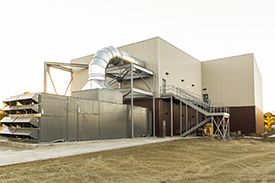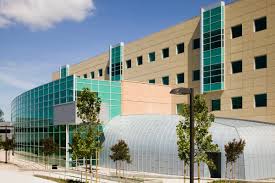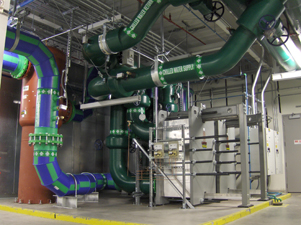ASC facilities include both the necessary physical facilities and the operational support for reliable, cross-lab production computing and storage environments. Also included is the suite of user services needed for effective use of ASC tri-lab computing resources. The scope of facility operations at LLNL includes planning, integration and deployment, continuing product support, software license and maintenance fees, procurement of operational equipment and media, quality and reliability activities, and collaborations. Facility support covers physical space, power and other utility infrastructure, and local area network (LAN)/wide area network (WAN) networking for local and remote access, as well as requisite system administration, cyber-security, and operations services for ongoing support and addressing system issues.
Exascale Computing Facilities Modernization
Completed in June 2022, the Exascale Computing Facility Modernization (ECFM) project provides essential upgrades including a significant boost to the power and water-cooling capacity of LCC B453 with 85 megawatts of electricity (up from 45 megawatts) and 28,000 tons of cooling (up from 10,000 tons).
The upgraded utilities prepare LCC to move into the exascale era and not only site NNSA’s first exascale system, El Capitan, but bring a second exascale-class system online simultaneously in the next decade. The next-generation machines will allow NNSA and the ASC program to meet the certification requirements of the Stockpile Stewardship Program and aid in future design efforts.
For more information, download the ECFM Fact Sheet.
Building 654 in the Livermore Computing Complex
Sited at Lawrence Livermore National Laboratory (LLNL), the dual-level modular Building 654 houses platforms acquired as part of the commodity technology systems (CTS-1) procurement. Constructed with economy and adaptability in mind, the building consists of a 6,000-square-foot machine floor flanked by support space. The design of the main computer structure is flexible to allow for possible expansion and to accommodate future computer technology advances in high performance computing (HPC).
B654 provides unclassified HPC system space suitable for supporting the National Nuclear Security Administration's (NNSA's) Advanced Simulation and Computing (ASC) Program, other related national security missions, and collaborations with academia. ASC is the simulation effort for NNSA's stockpile stewardship program to ensure the safety, security and effectiveness of the nation's nuclear deterrent without additional underground testing.
For more information, download the 2022 B654 fact sheet.
Building 453 in the Livermore Computing Complex
LLNL's world-class computing facility, LCC B453, was designed for multiple generations of supercomputers. The modern structure includes:
- A four-story office tower, with 121,600 square feet for 285 offices, a visualization theater, a 150-seat auditorium, and several conference rooms.
- A machine floor, with 48,000 square feet of unobstructed computer room floor, 45 megawatts machine power capacity, and 7,200 tons of air conditioning capacity. The building is being upgraded to 85 megawatts, with commensurate cooling, in anticipation of future exascale computing needs.
- A mechanical cooling system, with cooling towers boasting total capacity of 12,600 gallons per minute, a chiller plant with total capacity of 7,200 tons, air handlers with a total capacity of 2,720,000 cubic feet per minute, and a 3,600-gallon-per-minute, closed-loop, liquid-cooling system.
In 2010, LCC B453 received a Leadership in Energy and Environmental Design (LEED) gold level certification under the U.S. Green Building Council (USGBC) rating system. LEED is an internationally recognized green building certification system that provides third-party verification that a building or community was designed and built using strategies aimed at improving performance in energy savings, water efficiency, carbon dioxide emissions reduction as well as other factors.









